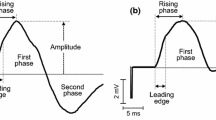Abstract
The possibility of solving the inverse problem in electroneurography, i.e. of estimating the main parameters specifying the activated fibre's functional state, using the amplitude and integral characteristics of the surface potentials generated by infinite homogeneous fibres, has been analysed. An analytical expression has been found for the amplitude of the negative phase Anph of the single fibre extracellular action potential (SFEAP) as a function of the wavelength b, the fibre-electrode distance y and a scale factor Ao proportional to the intracellular action potential amplitude Vm, to the square of the fibre radius a and to the ratio of the axoplasm conductivity τa and volume conductor conductivity τe. For a large fibre-electrode distance, typical of surface recordings, an analytical expression of the integral of the negative phase Inph of the SFEAP as a function of Ao, b, y and the propagation velocity v was also found. Simple methods are proposed for estimating v, the location of the electrical centre of the activated fibres' territory and the product of the number of activated fibres N, duration Tin of the intracellular action, potential and of the factor Ao. The estimation errors due to the temporal and spatial dispersion of the activated fibres were analysed as a function of the fibre-electrode distance and the territory shape.
Similar content being viewed by others
References
Broman, H., Bilotto, G. andDeLuca, C. J. (1985) Myoelectric signal conduction velocity and spectral parameters: influence of force and time.J. Appl. Physiol.,58, 1428–1437.
Davies, S. andParker P. (1987) Estimation of myoelectric conduction velocity distribution.IEEE Trans.,BME-34, 365–374.
Dimitrov, G. V. andDimitrova, N. A. (1974a) Influence of the asymmetry in the distribution of the depolarized level on the extracellular potential field generated by an excitable fibre.Electromyogr. Clin. Neurophysiol.,14, 225–275.
Dimitrov, G. V. andDimitrova, N. A. (1974b) Extracellular potential field of an excitable fibre immersed in anisotropic volume conductor.,14, 437–540.
Dimitrov, G. V. andDimitrova, N. A. (1977) Bipolar recording of potentials generated by excitable fibres in a volume conductor.Agressologie,18, 235–252.
Dimitrov, G. V. (1987) Changes in the extracellular potentials produced by unmyelinated nerve fibre resulting from alternations in the propagation velocity or the duration of the action potential.Electromyogr. Clin. Neurophysiol.,27, 243–249.
Dimitrov, G. V., Dimitrova, N. A. andLateva, Z. C. (1989) Integral characteristics of extracellular single fibre action potentials.,29, 195–201.
Dimitrova, N. A. (1973) Influence of the length of the depolarized zone on the extracellular potential field of a single unmyelinated nerve fibre.,13, 547–558.
Helmholtz, H. (1853) Uber einege Gesetze der Vertheilung elektrischer Ströme in körperlischen Leitern mit Anwendung auf die thierischelektrischen Versuche.Ann Phys. Chem.,29, 222–227.
Hunter, I. W., Kearney, R. E. andJones, L. A. (1987) Estimation of the conduction velocity of muscle action potentials using phase and impulse response function techniques.Med. & Biol. Eng. & Comput.,25, 121–126.
Jasrotia, V. S. andParker, P. A. (1983) Matched filters in nerve conduction velocity estimation.IEEE Trans.,BME-30, 1–9.
Lindström, L., Magnusson, R. andPetersen, I. (1970) Muscular fatigue and action potential conduction velocity changes studied with frequency analysis of EMG signals.Electromyogr.,10, 341–356.
Lorente de Nó, R. (1947) A study of nerve physiology, InStudies from the Rockefeller Institute for Medical Research,132, 384–477.
Lynn, P. A. (1979) Direct on-line estimation of muscle fiber conduction velocity by surface electromyography.IEEE Trans.,BME-26, 564–571.
Naeije, M. andZorn, H. (1983) Estimation of action, potential conduction velocity in human skeletal muscle using the surface EMG cross-correlation technique.Electromyogr. Clin. Neurophysiol.,23, 73–80.
Parker, P. A. andScott, R. N. (1973) Statistics of thee myoelectric signal from monopolar and bipolar electrodes.Med. & Biol. Eng. & Comput.,11, 591–596.
Pattle, R. E. (1971) The external action potential of a nerve or muscle fibre in an extended medium.Physics in Med. & Biol.,16, 673–685.
Plonsey, R. (1974) The active fibre in a volume conductor.IEEE Trans.,BME-21, 371–381.
Rababy, H., Kearney, R. E. andHunter, I. W. (1989) Method for EMG conduction velocity estimation which accounts for input and output noise,Med. & Biol. Eng. & Comput.,27, 125–129.
Rosenfalck, P. (1969) Intra-and extracellular potential fields of active nerve and muscle fibres. A physiomathematical analysis of different models.Acta Physiol., Scand.,75, Suppl. 321, 1–168.
Sollie, G., Hermens, H. J., Boon, K. L., Wallinga-de Jonge, W. andZilvold, G. (1985) The measurements of the conduction velocity of muscle fibres with surface EMG according to the cross-correlation method.Electromyogr. Clin. Neurophysiol.,25, 193–204.
Stulen, F. B. andDeLuca, C. J. (1981) Frequency parameters of the myoelectric signal as a measure of muscle conduction velocity.IEEE Trans.,BME-28, 515–523.
Trayanova, N. A. andDimitrov, G. V. (1982) Extracellular potentials in the proximity of the excitable fibres.Electromyogr. Clin. Neurophysiol.,22, 291–301.
van der Vliet, G. H., Holsheimer, J. andBingmann, D. (1980) Calculation of the conduction velocity of short nerve fibres.Med. & Biol. Eng. & Comput.,18, 749–757.
Zwarts, M. J. (1989) Applications of muscle fiber conduction velocity estimation. A surface EMG study. Ph.D. Thesis., University of Groningen, The Netherlands.
Author information
Authors and Affiliations
Rights and permissions
About this article
Cite this article
Dimitrov, G.V., Lateva, Z.C. & Dimitrova, N.A. Radial changes of extracellular potential amplitude and integral characteristics and the inverse problem in electroneurography. Med. Biol. Eng. Comput. 30, 357–363 (1992). https://doi.org/10.1007/BF02446975
Received:
Accepted:
Issue Date:
DOI: https://doi.org/10.1007/BF02446975




